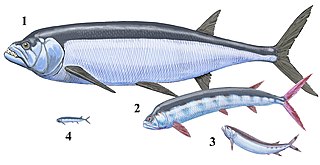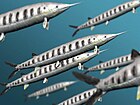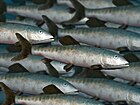
Clupeiformes is the order of ray-finned fish that includes the herring family, Clupeidae, and the anchovy family, Engraulidae. The group includes many of the most important forage and food fish.

Gasteroclupea is a genus of prehistoric ellimmichthyiform fish that is distantly related to modern anchovies and herrings. It contains one species, G. branisai. It inhabited freshwater or estuarine habitats across South America during the Campanian and Maastrichtian stages of the Late Cretaceous period, and it briefly survived beyond the K-Pg boundary into the Danian stage of the Paleocene, making it among the few genera from its order to survive into the Cenozoic. Fossils of the genus have been found in the Yacoraite Formation of Argentina, the Chaunaca Formation, Santa Lucía Formation, and El Molino Formation of Bolivia, and the Navay Formation in Venezuela.

Ichthyodectiformes is an extinct order of marine stem-teleost ray-finned fish. The order is named after the genus Ichthyodectes, established by Edward Drinker Cope in 1870. Ichthyodectiforms are usually considered to be some of the closest relatives of the teleost crown group.

Mawsonia is an extinct genus of prehistoric coelacanth fish. It is amongst the largest of all coelacanths, with one quadrate specimen possibly belonging to an individual measuring 5.3 metres in length. It lived in freshwater and brackish environments from the late Jurassic to the mid-Cretaceous of South America, eastern North America, and Africa. Mawsonia was first described by British paleontologist Arthur Smith Woodward in 1907.

Aphanepygus is an extinct genus of prehistoric marine holostean ray-finned fish that lived during the upper Cenomanian. It inhabited the former Tethys Ocean, with remains known from Lebanon and Croatia. Its exact affinities are uncertain, although it is usually recovered as a relative of the macrosemiids. However, other authorities recover it in the Ionoscopiformes.
Chanopsis is an extinct genus of prehistoric freshwater bonytongue relative that lived from the late Aptian to the Albian stage of the Early Cretaceous epoch. It contains a single species, C. lombardi from the Democratic Republic of the Congo.

Araripichthys is an extinct genus of marine ray-finned fish that lived from the Aptian to Coniacian stages of the Cretaceous period. The genus is named after the Araripe Basin, where it was found in the Crato and Santana Formations. Other fossils of the genus have been found at Goulmima in Morocco, the Tlayua Formation of Mexico and the Apón Formation of Venezuela.
Ctenocephalichthys is an extinct genus of prehistoric marine ray-finned fish, generally considered a holocentriform, that lived during the Late Cretaceous. It is known from Cenomanian to the Santonian of Lebanon.

Alloberyx is an extinct genus of prehistoric marine ray-finned fish, possibly a holocentrid, that lived during the Santonian of Lebanon, from the Sahel Alma site. It contains two species, A. syriacus, initially described as a species of Pseudoberyx, and A. robustus, initially classified in the genus Serratocentrus.
Luisiella is an extinct genus of prehistoric bony fish that lived during the Kimmeridgian stage of the Late Jurassic epoch. Fossils of the genus have been found in either the Cañadón Calcáreo Formation or Cañadón Asfalto Formation in Chubut Province, Argentina.
Austropleuropholis is an extinct genus of freshwater ray-finned fish that lived during the Late Jurassic. It contains a single species, A. lombardi, from the Kimmeridigian of the Democratic Republic of the Congo, from the terrestrial/freshwater series of the Stanleyville Formation.
Clupavus is an extinct genus of marine ray-finned fish that lived during the middle of the Cretaceous period. It is known from North Africa, Europe, Brazil, and possibly North America.
This list of fossil fishes described in 2013 is a list of new taxa of placoderms, fossil cartilaginous fishes and bony fishess of every kind that have been described during the year 2013. The list only includes taxa at the level of genus or species.
This list of fossil fishes described in 2016 is a list of new taxa of jawless vertebrates, placoderms, acanthodians, fossil cartilaginous fishes, bony fishes and other fishes of every kind that have been described during the year 2016, as well as other significant discoveries and events related to paleontology of fishes that occurred in the year 2016. The list only includes taxa at the level of genus or species.
This list of fossil fishes described in 2019 is a list of new taxa of jawless vertebrates, placoderms, acanthodians, fossil cartilaginous fishes, bony fishes, and other fishes of every kind that were described during the year 2019, as well as other significant discoveries and events related to paleoichthyology that occurred in 2019.
This list of fossil fishes described in 2020 is a list of new taxa of jawless vertebrates, placoderms, acanthodians, fossil cartilaginous fishes, bony fishes, and other fishes of every kind that were described during the year 2020, as well as other significant discoveries and events related to paleoichthyology that occurred in 2020.
Pleuropholidae is an extinct family of stem-teleost fish that lived from the Middle Jurassic to the Early Cretaceous. It is one of several families that were historically placed in the paraphyletic order Pholidophoriformes. Pleuropholids can be distinguished from other "pholidophoriforms" by the elongated scales on the sides of their bodies.
This list of fossil fish research presented in 2023 is a list of new fossil taxa of jawless vertebrates, placoderms, cartilaginous fishes, bony fishes, and other fishes that were described during the year, as well as other significant discoveries and events related to paleoichthyology that occurred in 2023.

The Akrabou Formation is a Late Cretaceous -aged geological formation and Konservat-Lagerstätte in Morocco. It overlies the slightly older freshwater deposits of the Kem Kem Group, which it was once thought to be apart of. It was deposited over following the Kem Kem ecosystem's submergence by the Tethys Ocean during a marine transgression from the Cenomanian-Turonian boundary event, as part of a wider deposition of carbonate platforms across the region from the event.















